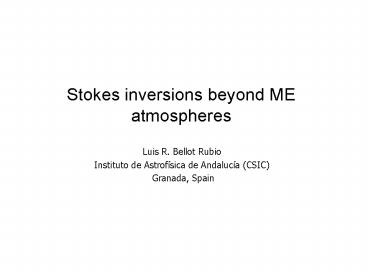Inversions based on ME atmospheres - PowerPoint PPT Presentation
1 / 17
Title:
Inversions based on ME atmospheres
Description:
POlarimetric LIttrow Spectrograph KAOS. VTT, Observatorio del Teide ... TRIPPEL spectrograph AO. Swedish 1-m Solar Telescope, La Palma. Dark-cored penumbral ... – PowerPoint PPT presentation
Number of Views:13
Avg rating:3.0/5.0
Title: Inversions based on ME atmospheres
1
Inversions based on ME atmospheres
Stokes inversions beyond ME atmospheres
Luis R. Bellot Rubio Instituto de Astrofísica de
Andalucía (CSIC) Granada, Spain
2
Inversions based on ME atmospheres
- ME atmosphere
- Source function is linear with optical depth
- Absorption matrix does not vary with optical
depth - Analytical Stokes profiles
- Fast inversion
- Smooth maps of physical quantities
- Results are easy to interpret
- Simplistic treatment of radiation transfer
- Little thermal information. No height variations
- Cannot account for asymmetric Stokes profiles
3
Asymmetric Stokes profiles
- Spatial resolution ?1"
- Advanced Stokes Polarimeter
- DST, Sac Peak
- Footpoints of cool coronal loops
Nagata, Bellot Rubio, Katsukawa (2006)
4
Asymmetric Stokes profiles
Fe I 630.15 and 630.25 nm
- Spatial resolution 0.6 arcsec
- Spatial resolution ?0.7"
- POlarimetric LIttrow Spectrograph KAOS
- VTT, Observatorio del Teide
- Temporal evolution of a bipolar MMF
Cabrera Solana et al. (in preparation)
5
Asymmetric Stokes profiles
- Spatial resolution ?0.4"
- KIS/IAA Visible Imaging Polarimeter TESOS
KAOS - VTT, Observatorio del Teide
- Pore near disk center
Bellot Rubio et al. (in preparation)
6
Asymmetric Stokes profiles
- Spatial resolution ?0.2"
- TRIPPEL spectrograph AO
- Swedish 1-m Solar Telescope, La Palma
- Dark-cored penumbral filaments
Bellot Rubio, Langhans, Schlichenmaier (2005)
7
ME inversions of asymmetric profiles
MHD simulations (Vögler et al. 2005)
- Fe I 630.1 and 630.2 profiles degraded to SP
pixel size
8
ME inversions of asymmetric profiles
MHD simulations (Vögler et al. 2005)
- Fe I 630.1 and 630.2 profiles degraded to SP
pixel size - Maps of inferred B and vLOS very similar to real
ones!
9
ME inversions of asymmetric profiles
Stokes V/I
MHD simulations (Vögler et al. 2005)
ME inv
ME inv
- Asymmetric profiles not well fitted
- ME results are some kind of average of physical
parameters along the LOS
10
The origin of asymmetries
Different magnetic atmospheres coexisting in
resolution element
Amplitude asymmetry/ Abnormal Stokes profiles
Gradients/discontinuities of physical parameters
along LOS
Area asymmetry
Auer Heasley (1978)
RF of V to B
RF of I to vLOS
RF of I to vLOS
The area asymmetry can be used to derive the
height variation of atmospheric parameters
Cabrera Solana et al. (2005)
11
Available codes for inversions with gradients
SIR
Ruiz Cobo
del Toro Iniesta (1992)
1C 2C atmospheres, arbitrary stratifications,
any photospheric line
SIR/FT
Bellot Rubio et al. (1996)
Thin flux tube model, arbitrary stratifications,
any photospheric line
SIR/NLTE
Socas-Navarro et al. (1998)
NLTE line transfer, arbitrary stratifications
SIR/GAUS
Bellot Rubio (2003)
Uncombed penumbral model, arbitrary
stratifications
SPINOR
Frutiger Solanki (2001)
1C 2C atmospheres, arbitrary stratifications,
any photospheric line, molecular lines, flux tube
model, uncombed model
LILIA
Socas-Navarro (2001)
1C atmospheres, arbitrary stratifications
MISMA IC
Sánchez Almeida (1997)
MISMA model, arbitrary stratifications, any
photospheric line
12
Accounting for gradients
- Inversion codes capable of dealing with gradients
- Are based on numerical solution of RTE
- Provide reliable thermal information
- Use less free parameters than ME codes (7 vs 8)
- Infer stratifications of physical parameters with
depth - Produce better fits to asymmetric Stokes profiles
- Height dependence of atmospheric parameters is
needed for - 180o azimuth disambiguation
- 3D structure of sunspots and pores
- Magnetic flux cancellation events
- Polarity inversion lines
- Dynamical state of coronal loop footpoints
- ..
13
Inversions with gradients
- Spatial resolution ? 0.5"
- Intensity profiles of Fe I 557.6 nm
- Inversion SIR with 7 free parameters
- Thermal/kinematic structure of AR 0019 at
different heights in the photosphere
Bellot Rubio, Schlichenmaier, Tritschler (2006)
14
Inversions with gradients
- Spatial resolution ?0.4"
- VIP TESOS KAOS
- Inversion SIR with 10 free parameters
15
Retrieving gradients from SOLAR-B/SP data
How much do gradients cost? SIR inversion with
10 free parameters Dual Xeon workstation _at_ 2.8
GHz 2 spectral lines, 136 wavelengths, 4 Stokes
parameters, model atmosphere discretized in 41
grid points
0.7 s per pixel
0.5 s per pixel
Worst-case scenario (real-time inversions)
Instrument
Pixels
Cost
Time
Workstations
SOLIS/VSM
4 x 105
3 hours?
20
50 000
POLIS
450
50 000
10 s
20
SOLAR-B/SP
1000
200 000
5 s
100
16
Optimizations of SIR
- Paralellization (MPI)
- Designed for use with Linux clusters
- Speed increases linearly with number of
processors - Status Already available (L.Bellot)
- Porting source code to Fortran 90
- More flexibility, efficiency, and speed
- Better management of memory allocation and array
operations - Keep I/O to a minimum
- Status in progress (B. Ruiz Cobo)
- Use of look-up tables for spectral syntheses
- Pe as a function of T and Pg
- Absorption coefficients as functions of T and Pe
- Speed gain a factor 10-20
- Status Already available (B. Ruiz Cobo)
17
Proposed strategy
- Baseline ME inversions of all SP scans
- Identify
- Pixels with bad fits and/or large asymmetries
- Regions where interesting physical processes
occur - Run inversions with gradients on these pixels
- Use ME results as initialization
- Not only linear stratifications, but also more
complex height dependences will often be needed. - Two-component model atmospheres may be required
- Critical issues
- Clarify limitations of 6301 and 6302 for quiet
Sun magnetic field studies - Development of efficient visualization tools























![The radiance received by a spaceborne or airborne instrument looking at nadir at an altitude of Z (km) is described by the RTE for plane parallel atmospheres as stated by Lenoble [1] is given by: PowerPoint PPT Presentation](https://s3.amazonaws.com/images.powershow.com/7507119.th0.jpg?_=20160102061)







